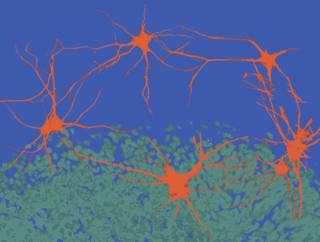
Department of Ophthalmology
This piece was inspired by how our brains process information.
Working from left to right, the painting demonstrates how the eye breaks down an image and sends information to the brain. The brain encodes various patterns from the eye and translates them into the image we see.
One essential step in this process is the encoding of the image in binary sequences (0s and 1s) to the brain. These binary sequences are viewed as “words” and are processed by the brain.
I wanted to illustrate this complex process. In short, the process includes breaking down an image into pixels, sorting it by variability, transferring this information to light waves, then into electrical pulses (depicted as both a circuit board and voltage readings) then into a binary code that the brain understands and, ultimately, back into its reflected image.




